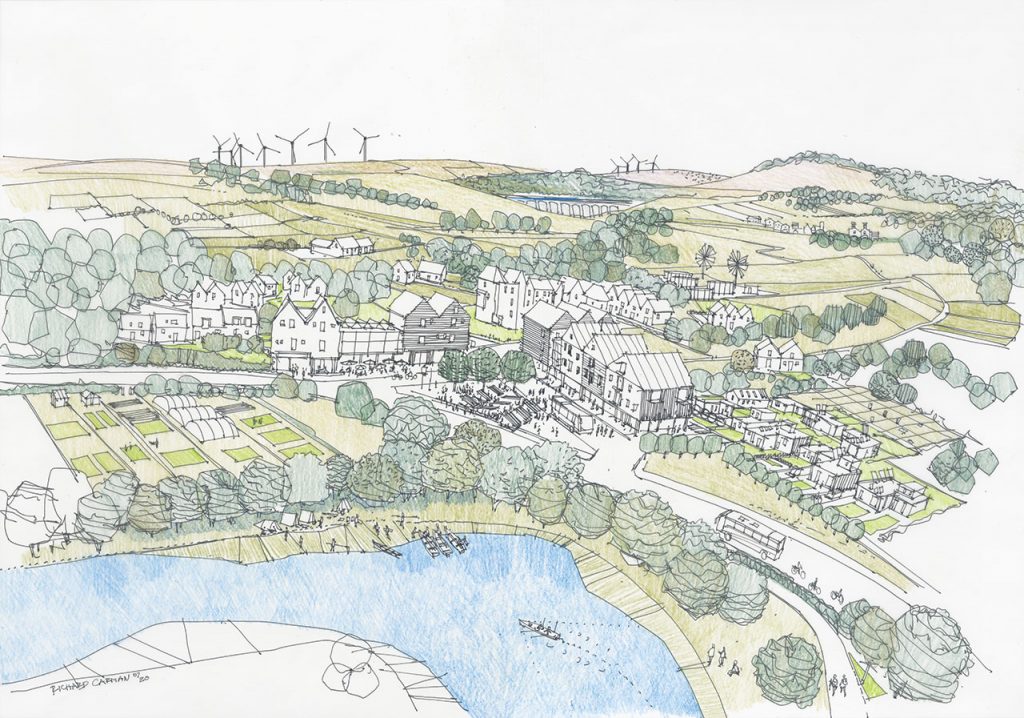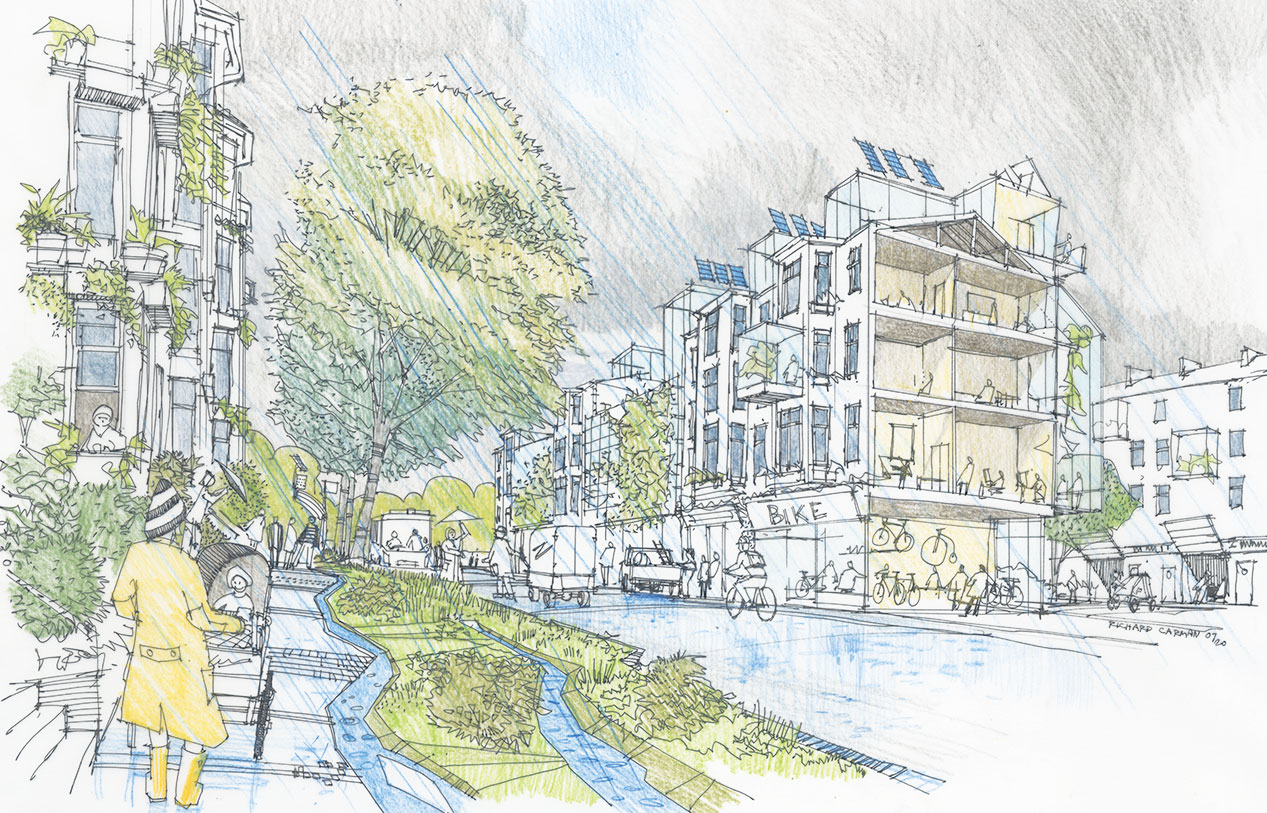Heather Claridge AoU explores how places can support decarbonisation
One of the greatest threats to our health is climate change. It impacts our water, food, air and shelter — the basic needs for survival. How places are planned, designed and developed has a significant influence on our ability to respond to the changing climate and in turn, impacts our quality of life.
The need to prioritise climate action in the built environment has risen to the fore in recent years, helped by campaigns such as Architects, Landscape Architects and Planners ‘Declare’. However, to scale up efforts we must now turn our attention to the ways in which we effectively work together to achieve more climate-resilient, healthy places.
In 2019, Architecture & Design Scotland was approached by the Energy and Climate Change Directorate of the Scottish Government to help implement Scotland’s Climate Change Act and Plan at a local level. With the introduction of a target to become a net-zero carbon society by 2045, there was a recognition that support could be given to, and insight gained from, practical and creative ways places can work towards achieving this ambition.
A ‘learning by doing’ approach formed the foundation of the project. This involved partnering with four local authorities to support the development and implementation of plans that prioritise decarbonisation and climate action. The Shetland Islands Council, Moray Council, Glasgow City Council and Loch Lomond and the Trossachs National Park areas were chosen for their diversity in scale, geography, approach, stage and context, helping to provide valuable lessons for future projects. Despite their differences, each authority was at a juncture point in their process and required tailored support.
People-centred design
Setting people at the heart of our plans and places is critical — particularly when there is a need to facilitate everyday behaviour changes to live lower-carbon lives. This is often challenging when proposed developments do not have an existing community of residents, as was the case in Shetland, which involved the delivery of the masterplan for a new mixed-use community in Knab, a large former school site on the edge of Lerwick town centre.
To help explore the story of change through the viewpoint of people, five different ‘personas’ were created — each presenting different needs such as a requirement for easy access to health facilities, opportunities for sharing resources, reduced energy costs, connections to wildlife and accessible public transport.
During a workshop, local councillors, council officers and partner organisations worked in small groups to consider what those individual personas would need to live a happy, healthy and low-carbon life in the new community and how they could be involved with its delivery. Overall, this helped to explore ways the Knab development could support a lower carbon lifestyle for its future residents and neighbours.
This exercise emphasised to the partners and decision-makers the critical need for key infrastructure such as open space, community facilities, paths and public transport to be delivered with — or even in advance of — the first phase, to prevent the early residents from being socially and economically disadvantaged and forming ‘bad’ carbon-intensive habits. With 49% of households in Shetland currently not earning enough to live well, delivering climate benefits alongside offsetting rising living costs remains one of the key drivers for the scheme.
Of course, the ‘personas’ approach is not a substitute for effective community engagement, but it can be a helpful tool for imagining needs of future communities, or for use in briefings for new developments without existing residents.

Exploring jeopardy
The full impact of climate change on our future is not certain. A valuable technique to explore uncertainty is scenario planning that allows people to look long-term and imagine an aspirational future, rather than accepting past or current trends. While not designed to arrive at a specific answer, the method is useful to conceive, explore and evaluate a series of future conditions and the outcomes —in turn, helping to scope out a preferred and feasible course of action.
In order to bring climate change and carbon reductions to the forefront of workshop discussions in Loch Lomond and the Trossachs National Park, a scenario planning exercise was created for the Strathard area. This involved using two timelines to 2050 which mapped out the impact of inaction (scenario 1) and direct focus (scenario 2) on climate change, and the consequences these would have on the liveability of the area.
The timelines highlighted events such as ‘the persistent overuse of the local road network by HGVs and coaches resulting in significant damage in 2025; a drop in permanent residents leading to the closure of the local health centre in 2029; the delivery of a Park Power project, producing 100% of the energy demand locally in 2040; and climate-exacerbated disease impacting the area’s woodland in 2049’.
Workshop participants worked in groups to consider the two imaginary futures, exploring how the different events would impact the area and what needed to happen now either to prevent population decline or support sustainable growth. This session was designed to prompt a reaction, unite the disparate stakeholders and instil a sense of urgency in planning for the changing climate.
A real potential threat to the process of planning for the changing climate is stakeholder complacency. In places where there has already been significant investment in key climate action, such as flood defences or district heating networks, there is a risk that other climate pressures may get overlooked. Testing ideas through scenario planning is a powerful way to help position climate change as a present, complex and unifying challenge.
Eight guiding principles
The combined findings from the collaborative work with the different places were distilled into eight guiding principles for Carbon Conscious Places. The principles not intended to be used as a definitive list or set of solutions, instead they aim to encourage an interconnected and whole place approach to the climate and carbon challenge.
1. A place-led approach: This involves working with existing assets, landscape and place identity. Using the right type of intervention, at the right stage, scale and location.
2. A place of small distances: This encourages the creation of complete neighbourhoods with everyday services and facilities within a short walking or cycling distance.
3. A network of small distance places: This involves connecting complete neighbourhoods to provide a network of places that support greater self-sufficiency and low carbon living. Enabling people to live, work and play without generating unnecessary carbon emissions.
4. A place designed for and with local people: This involves placing people’s needs at the centre of decision-making, service provision and investment in our places and ensuring they are actively involved in key stages of the design process.
5. A place that reuses, repurposes and considers whole life costs: This supports the retrofitting of existing structures and brownfield sites first, giving consideration to embodied carbon in place. This principle supports viewing structures as ‘material banks’ with components which are demountable, rebuildable and reusable and considering the entire lifecycle cost of a structure rather than only its initial capital costs.
6. A place with whole and circular systems: This involves enhancing, repairing and joining up the different systems which support a healthy, carbon-conscious place.
7. A place that supports sharing: This encourages the sharing of assets and services in places to enable lower carbon living and connects people to their neighbourhoods. This can range from sharing tools, bikes, electric vehicles to accommodation and education facilities.
8. A place designed in time: This involves ensuring the place planning and delivery process considers the dimension of time from long term visions to short-term approaches to test ideas.
Considering different scales of places
The Carbon Conscious Places report produced by the project considers how the principles can apply at four settlement scales – an urban neighbourhood, a city centre, a town and a rural community. By rethinking how we move about, how we live and how we become more self-sufficient, we are able to consider different ways to reduce, repurpose and absorb carbon and adapt to the impacts of climate change.
This helps to visualise how a Carbon Conscious Scotland can be delivered by 2050 and contribute to the UN’s Sustainable Development Goals. The report provides examples of the story of change for each place, reflective of the bold and collective action required by the public, private, third and community sector.
Drawing conclusions
The Carbon Conscious Places project has attempted to frame climate issues differently and tailor tools and interactions to the specific context of different places. This has helped to translate national policy and complex issues to local contexts. Although there is no silver bullet for our climate and health-related challenges, the eight Carbon Conscious Places principles form a useful combination to continue to shift our reliance on carbon-intensive developments, services and modes of transport, through a ‘whole place’ approach.
Heather Claridge AoU is a principal design officer for Architecture and Design Scotland – Scotland’s design agency. She is currently on secondment from Glasgow City Council from 2019 to 2021.






